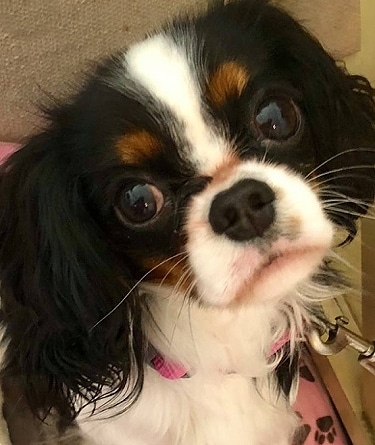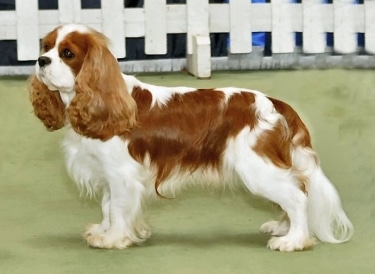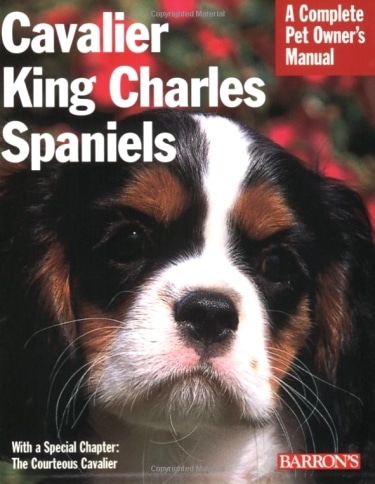
The Cavalier King Charles Spaniel is descended from the English Toy Spaniel (King Charles Spaniel) and other small toy Spaniels seen in many sixteenth, seventeenth, and eighteenth century paintings and tapestries with aristocratic families. Cavalier King Charles Spaniels were considered a luxury since they were not working dogs.
King Charles II was very fond of spaniels and always had two or three with him. He so much favored these dogs that he wrote a decree that which allowed them to be accepted into any public place which included the Houses of Parliament. In England this decree is still in existence today.
Over time, toy spaniels’ popularity faded and was replaced by the Pug. In the 1920s, American Roswell Eldridge traveled to England in search of two ‘old type’ spaniels like those in earlier paintings and tapestries. Initially he was unsuccessful, so he then offered twenty five pounds at the Crufts Dog Show each year to the best male and female which resembled the dogs in King Charles II’s reign. This strategy eventually worked, however, Mr. Eldridge passed away before ever seeing the results.
The first Cavalier King Charles Spaniel entered America in 1952. Because of the small numbers of this breed, they did not gain full breed recognition until January of 1996. The Cavalier King Charles Spaniel is AKC’s 140th breed.
Height: The height of a Cavalier King Charles Spaniel is between 12 – 13 inches (30-33 cm)
Weight: The weight of a Cavalier King Charles Spaniel is between 10 – 18 pounds (5-8 kg)
Coat Type: The Cavalier King Charles Spaniel’s coat is long, silky and soft. No curls although a slight wave is permissible. It grows lengthy feathering on their ears, chest, legs, feet and tail and breed standards demand this be kept long. Feathering on the feet is a feature of this breed. Due to the length of the Cavalier King Charles Spaniel’s coat, it is important to keep it well groomed. To keep the coat from being matted, a daily brushing is recommended.
Color: The Cavalier King Charles Spaniel breed has four recognized colors: 1. Blenheim – rich chestnut on pearly white background 2. Tricolor – black and white with tan markings on cheeks, inside ears, on eyebrows, inside legs, and on underside of tail 3. Black & tan – black with tan markings 4. Ruby – rich reddish-brown all over.

Temperament: The Cavalier King Charles Spaniel is very affectionate, friendly, playful, intelligent and very social. These dogs are eager to please and love to be around people. Cavalier King Charles Spaniels do well with gentle obedience training and usually get along with other dogs. This breed loves companionship and does well with people of all ages. It is not recommended to leave Cavalier King Charles Spaniels alone all day – they’re known to suffer from separation anxiety.
Health Problems: The Cavalier King Charles Spaniel can suffer from two severe and common genetic conditions – mitral valve disease and syringomyelia. Mitral valve disease which is heart disease, is the most common cause of death of the Cavalier. Syringomyelia is an inherited neurological disease which affects the brain and spine. Other health issues include Episodic Falling which is an ‘exercise-induced paroxysmal hypertonicity disorder’ meaning that there is increased muscle tone in the dog and the muscles are unable to relax, hip dysplasia, keratoconjunctivitis sicca (dry eye) and other eye issues such as hereditary cataracts. Additional health concerns include ear problems and a congenital blood disorder.
Special Interest:
• This breed is historically a lap dog and not a working dog.
• The Cavalier King Charles Spaniel is AKC’s 140th breed and was fully recognized in January of 1996.
• The AKC recognizes the English Toy Spaniel (King Charles Spaniel) and Cavalier King Charles Spaniel as two separate breeds.
• The Cavalier King Charles Spaniel was Charlotte York’s dog in the HBO series, Sex and the City.
Classifications:
AKC: Toy Group
ANKC: Group 1 – Toy
CKC: Group 5 – Toy
FCI: Group 9 Section 7 #136
KC: Toy Group
UKC: Companion Breeds
Kennel.com Recommends Cavalier King Charles Spaniel
Cavalier King Charles Spaniel
 Kennel.com – Complete Guide to Dogs The Dog Lovers Guide
Kennel.com – Complete Guide to Dogs The Dog Lovers Guide